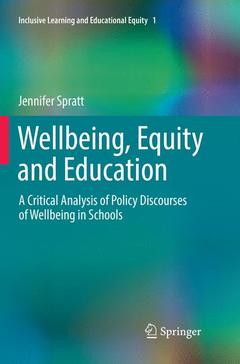Description
Wellbeing, Equity and Education, 1st ed. 2017
A Critical Analysis of Policy Discourses of Wellbeing in Schools
Inclusive Learning and Educational Equity Series, Vol. 1
Author: Spratt Jennifer
Language: English
Subjects for Wellbeing, Equity and Education:
Keywords
critical discourse analysis and wellbeing; wellbeing; social justice and schools; discourses of wellbeing; recontextualization of discourse; wellbeing and learning; curriculum of excellence; neoliberalism and wellbeing in schools; wellbeing; equity and education; capability approach and wellbeing in schools; wellbeing policy in education; Scottish education policy; education and human capital
Publication date: 07-2018
Support: Print on demand
Publication date: 02-2017
Support: Print on demand
Description
/li>Contents
/li>Comment
/li>
Brings clarity to the discursive complexity around wellbeing in schools
Critically examines the multi-faceted relationships between wellbeing and learning
Identifies dangers and opportunities for equality created by the discourses of wellbeing
Shows what teachers, uniquely, can bring to the wellbeing of children, through education
Includes supplementary material: sn.pub/extras




